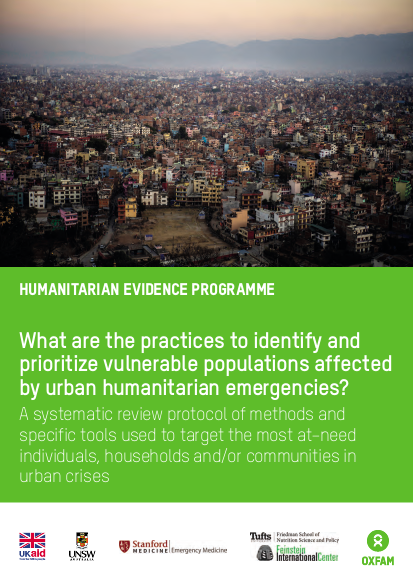Humanitarian Evidence Programme

International organizations working in humanitarian crisis settings recognize the need to improve urban emergency response and preparedness, which necessitates improved methods for assessing vulnerability within urban populations. Currently, the Sphere Handbook of guidelines and best practices for humanitarian response is being adapted to include the urban context (The Sphere Project, 2015). The Inter-Agency Standing Committee’s (IASC’s) strategy report on meeting humanitarian challenges in urban areas explains the need for targeting and enumerating vulnerable individuals and communities to better direct services (IASC, 2010). Similarly, the Active Learning Network for Accountability and Performance in Humanitarian Action (ALNAP) highlights the need for ‘specific efforts [to] be made to identify those groups who have particular need or high levels of need’ in urban emergencies (Sanderson and Knox-Clarke, 2012). More prominently and very timely, the first ever World Humanitarian Summit (WHS) will review current practice and help inform future humanitarian challenges through global and expert consultations. Various working groups are an integral part of this process. They are charged with drafting the urban charter and recommendations for urban crisis response, such as the urban expert working group, to which the review team belongs and currently contributes. The Global Alliance for Urban Crises has also evolved out of these efforts. The alliance brings together a broad array of stakeholders to specifically recognize the growing and unique challenge of urban crises, promote this agenda at the WHS and beyond and work to improve operational practice in urban crises.
Recent crises have further emphasized the need for vulnerability assessment criteria and functional targeting methods. In Nepal, efforts by the government to equitably distribute resources in the wake of the earthquake resulted in many organizations being spread too thin and caused concern within humanitarian organizations that the most vulnerable were being overlooked because they lacked title deeds and/or proper identification. The Disaster Emergency Committee (DEC) and the Humanitarian Coalition’s review of the Nepal earthquake response pushes for improved targeting that considers the proportional impact of a disaster on vulnerable groups – the targeting needed either before or after a crisis to identify those most vulnerable to the impact of a shock (DEC/HC, 2015). Similarly, relief efforts in Port-Au-Prince following the 2010 Haiti earthquake also highlighted the need for improved resource targeting, where, for example, a majority of the population lived below Sphere standards prior to the earthquake and inadequate targeting of response resulted in uneven resource distribution (ALNAP/DAC/UNEG, 2010).
As organizations struggle to identify vulnerable populations in urban crises, they are challenged by the fact that in many rapidly growing and fragile cities, many people are living in extreme vulnerability even before the onset of an acute crisis. We find that large urban populations live well below Sphere minimum standards at baseline, as found in a forthcoming paper by the review principal investigator and previous data collection in Nairobi slums (Concern Worldwide, 2014). This baseline vulnerability calculates directly into risk to health and well-being and translates back into loss when an acute crisis strikes (WHO, 2002). In these environments, practitioners report being overwhelmed by need and may adopt blanket targeting or essentially arbitrary/non-vulnerability based selection. The increasing need for guidance in urban crises, where Sphere and previous practices do not hold relevance, makes this review question particularly important and inviting to this team.
The answers to the review question also play an important role in preparedness, as the practices used to identify vulnerable populations in urban crises can be complementary to the pre-disaster phase of the humanitarian crisis cycle.
Resource collections
- Evaluating humanitarian action
- Monitoring and Evaluation (M&E)
- Monitoring of humanitarian action
- UN Habitat - Urban Response Collection
- Urban Response - Urban Crisis Preparedness and Risk Reduction
- Urban Response Collection - Community Engagement and Social Cohesion
- Urban Response Collection - Economic Recovery
- Urban Response Collection - Environment and Climate Change
- Urban Response Collection - Housing, Land and Property
- Urban Response Collection - Urban Crisis Response, Recovery and Reconstruction
- Urban Response Collection - Urban Resilience
